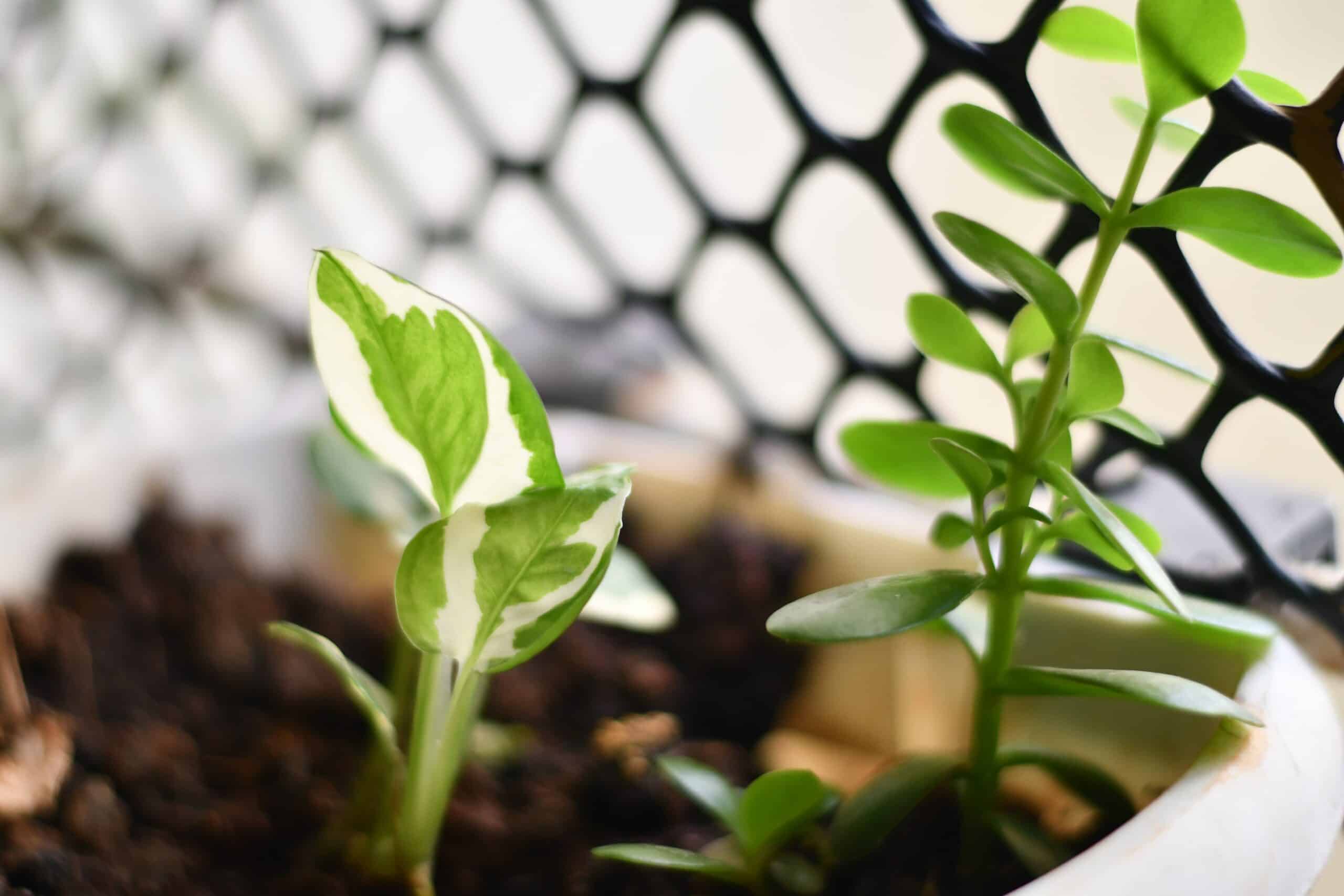Are you looking for an easy-going houseplant that will bring a cheerful pop of color to your home? The N’Joy Pothos is a great choice! This easy-care plant is versatile, attractive, and can be grown indoors or out. With its cascading foliage and bright green leaves, it’s the perfect way to add some life to any room. In this article, we’ll discuss how to grow and care for this beautiful plant so you can enjoy it for years to come.
The N’Joy Pothos is a great choice for those who want an effortless houseplant. It’s low maintenance and forgiving of novice gardeners; it’s also very hardy and can survive with minimal water and light. Plus, this vining plant looks beautiful when grown in containers or hanging baskets. With its unique variegated leaves, the N’Joy Pothos adds texture, color, and interest to any space—indoors or outdoors!
Finally, caring for the N’Joy Pothos is surprisingly simple! With just a few basic tips, you’ll be able to keep your plant thriving year round. From watering requirements to proper lighting needs, we’ll show you how to give your N’Joy Pothos the best possible care so you can enjoy its beauty for many years to come.
N’joy Pothos Overview
The n’joy pothos is a lush green beauty, a symbol of life’s potential and possibilities. Its trailing vines dangle with grace, reaching out to the sun in search of joy and growth. Its leaves are filled with hope, radiating a greener future for us all. It is an inspiring sight to behold, its energy radiating throughout the space it inhabits.
Caring for this delicate creature requires attention to detail. The n’joy pothos loves bright indirect sunlight, but be careful not to leave it in direct sunlight too long as it will easily burn its beautiful leaves. Water your pothos deeply but be sure to let it dry completely between waterings; soggy soil can lead to root rot. Keep the temperature around 65-75°F and mist regularly to increase humidity levels if needed.
The right pot can make all the difference in growing a healthy n’joy pothos plant. Choose one that has drainage holes at the bottom and enough room for the roots to grow; you may need a larger pot than you expect! Make sure your pot has good airflow and use a soil mix designed specifically for houseplants so your n’joy pothos can thrive indoors or outdoors when temperatures permit.
Choosing The Right Pot
Planting a pothos plant is an excellent way to add lush greenery to any home or office. Before picking out the perfect pot, there are several considerations that should be taken into account. Finding the right pot for n’joy pothos has the potential to make all the difference in its growth and health.
When selecting a pot for your n’joy pothos, it’s important to pay attention to size. The container should be big enough for the root system of your pothos plant, but not too large as this can cause overwatering and lead to root rot. It’s best to choose a pot with drainage holes at the bottom, as these will help reduce water-logging and ensure proper air flow around the roots. Additionally, it’s important that your pot is made from a material that is porous enough so that moisture can escape while still maintaining moisture levels in the soil.
The final factor when selecting a pot for your n’joy pothos is aesthetics – choose something that you love! There are many different materials, shapes, sizes and colors available on the market, so take some time to find one that works with your style and space. With care and consideration given to choosing the right pot for your n’joy pothos plant, you are sure to have a healthy and thriving plant for years to come. As you move onto planting your new addition, consider how factors such as soil type or lighting may affect its growth.
Planting N’joy Pothos
Planting N’Joy Pothos is like finishing a jigsaw puzzle – every piece needs to fit perfectly and be placed in its rightful place. To ensure successful growth and health, it’s essential to get the planting process right. Here’s how:
Descend into the depths of your garden centre or nursery and select a pot that works for you. The size should be relative to the size of your plant and an adequate drainage system must be present; otherwise, there’s potential for root rot.
Once you have your container, fill it with a soil mixture that’s both light and well-draining. When you’re ready, take the time to carefully unpot your n’joy pothos and check for any damage to its roots – if present, trim them back accordingly. Here are four steps to keep in mind when planting: •tLoosen soil around the edges of your container •tUtilize a chopstick or pencil to make holes for each root •tArrange roots so they all face downward in the pot •tGradually fill in soil around each root until full covered
When planting n’joy pothos, remember to give it a little extra TLC throughout this process as even small mistakes can cause problems later on down the line. Now that we’ve got our pothos planted, let’s move onto ensuring it gets all the light requirements needed…
Light Requirements For N’joy Pothos
Light is an essential factor for the growth of n’joy pothos. According to research, up to 65% of plants fail due to inadequate light. As such, it’s important to get the light requirements right in order to ensure that your plants thrive.
N’joy pothos prefer bright, indirect sunlight. Place them near a window that receives bright but filtered light throughout the day. Make sure you avoid direct sunlight as this can burn leaves and cause etiolation (stretching). Avoiding direct sun also helps prevent the leaves from losing their attractive variegation.
If you don’t have access to a window with good natural lighting, consider investing in a grow light such as fluorescent or LED lights specifically designed for indoor plants. Remember that n’joy pothos need 12-14 hours of darkness each day, so turn off your artificial lights at night. TIP: To make sure your n’joy pothos receive enough light, rotate them every few days so all parts of the plant get some sun exposure – this will help encourage even growth and keep those beautiful variegated leaves looking their best!
Watering N’joy Pothos
Watering is a critical step in caring for your n’Joy pothos. It’s best to water when the top inch of soil is dry, rather than on a schedule. Don’t let the soil get too soggy or else your plant might suffer from root rot. To water properly, use room temperature purified water and drench the soil until it’s saturated. Then, empty out any excess water that collects in the drip tray.
The amount of water you give your n’Joy pothos depends on how much light it gets and how big its container is. If you’re keeping it indoors with no direct sunlight, then you should only need to water every 10 days or so. For plants located outdoors and exposed to more sunlight, you’ll need to check the soil daily and add more water as needed.
If you’ve been neglectful in watering your n’Joy pothos, don’t worry — they are very tolerant plants! Just be sure to give them a thorough soaking once you start up again so they can recover quickly. With proper care and attention, your n’Joy pothos will thrive in whatever environment it’s placed in! Now that we’ve covered watering requirements for this amazing houseplant, let’s talk about fertilizing next…
Fertilizing N’joy Pothos
Fertilizing your n’joy pothos is an important step in keeping it healthy. According to a study done by Clemson University, 85% of gardeners have seen healthier plants when they fertilize their indoor houseplants.
To help your n’joy pothos thrive, you should use a water-soluble fertilizer at half the recommended strength. Fertilize your plant every two weeks during the growing season—from spring to fall—but avoid fertilizing in winter when the plant goes dormant. You can also add a slow-release fertilizer once every 6 months for best results.
When applying fertilizer, make sure to spread it evenly around the base of the plant and water thoroughly after application. This will help ensure that all of the nutrients are absorbed into the soil and get to the roots of your plant. TIP: If you notice any yellowing or wilting leaves on your n’joy pothos, it could be an indication that it needs more fertilizer.
Temperature Requirements For N’joy Pothos
Visually, N’Joy Pothos is a stunning plant. Its silver-green foliage cascades down from the sides of its pot, giving it an elegant look. To ensure your pothos stays healthy and grows strong, there are certain temperature requirements that need to be met.
When it comes to temperature for N’Joy Pothos, it prefers warm temperatures between 65°F to 80°F (18-27°C). It’s important to keep the temperature within this range as this will help support optimum growth. If you’re in a colder climate with temperatures below 50°F (10°C), then the N’Joy Pothos should be kept indoors where it can stay warm. It is also best to avoid keeping it in a drafty area, as sudden changes in temperature can shock the plant and cause damage.
To ensure your N’Joy Pothos gets enough warmth and light, try positioning it near an east or south facing window so that it receives gentle morning sunlight throughout the day. Additionally, if you have access to artificial lighting such as fluorescent lights or LED lights, this can also help supplement the natural light your pothos needs to thrive.
With these tips in mind, you’ll be able to provide your N’Joy Pothos with the perfect environment for optimal growth and health while striking a balance between warmth and humidity.
Humidity Requirements For N’joy Pothos
Humidity is an important factor in caring for your N’Joy Pothos. If the humidity of your home or office is low, then you will need to provide additional moisture for your plant. Here are a few tips on how to keep your N’Joy Pothos healthy and thriving:
- Place the pot in a tray filled with pebbles and water. When the water evaporates, it will help increase the humidity around your plant.
- Mist the leaves every day or two with a spray bottle of filtered water, or use a humidifier near the plant.
- Grouping together several plants can help increase humidity levels as well.
In addition to providing adequate humidity levels, you also need to make sure that your N’Joy Pothos is not exposed to extreme temperatures that could cause damage to its delicate foliage. Keep it away from drafts and direct sunlight as much as possible, especially during summer months when temperatures tend to be higher than usual. Make sure you adjust accordingly when you move it from one area of your home to another so that it can acclimate properly.
Now that you know how to provide appropriate temperature and humidity levels for your N’Joy Pothos, it’s time to discuss pruning techniques that will help keep it looking neat and tidy – while still keeping its beautiful cascading leaves intact!
Pruning N’joy Pothos
Pruning N’Joy Pothos is a great way to keep your plants looking healthy and vibrant. Not only does it maintain the size and shape of the plant, but it also encourages new growth. The best time to prune N’Joy Pothos is in the late spring or early summer when new growth has begun. Here are some tips for successful pruning:
First, identify any dead, wilted, or discolored leaves. These should be removed with clean scissors or shears. This will help keep pests away from the plant and also promote healthier growth overall. Also, look for any stems that are overgrown or too long and trim them back to encourage bushier growth. Make sure to leave at least two inches of stem above each leaf node so that the plant will continue to grow vigorously.
Finally, it is important to be aware of how much you are pruning your N’Joy Pothos. Too much pruning can cause stress on the plant which can lead to slower growth or even death if not done properly. Start off by removing only small amounts of foliage at a time until you get an idea of what works best for your particular plant. With proper care and attention, you can keep your N’Joy Pothos looking beautiful year-round!
The next step in caring for your N’Joy Pothos is learning about common pests that may affect it – such as aphids, mealybugs, spider mites, and scale insects – and how to treat them safely before they become a problem.
Common Pests Affecting N’joy Pothos
Unfortunately, pests can be a problem for n’joy pothos plants. Though they are generally easy to care for and maintain, they can still fall prey to certain pests. Thankfully, there are some steps you can take to help protect your plant. Let’s take a look at the common pests that may affect n’joy pothos plants.
Spiders, mites, mealybugs, aphids and scale insects are some of the most common pests that may attack n’joy pothos plants. Each of these pests has their own behavior and life cycle; however, all can cause damage to your plant if left unchecked. To keep them from taking over your plant, it is important to inspect your n’joy pothos regularly for signs of infestation and treat the affected areas if necessary.
In addition to regular inspection, there are several other methods you can try in order to prevent pest infestations on your n’joy pothos plants. Pruning off dead or dying leaves and stems can help reduce the risk of attracting pests. You should also remove any affected leaves or branches as soon as possible before they spread further into the plant. Finally, using natural insecticides or horticultural oils on foliage can help deter pest activity as well as providing additional nutrients and protection for your plant.
By following these simple steps and inspecting your n’joy pothos regularly for signs of infection, you will be able to protect it from unwanted pests while keeping it healthy and thriving!
Common Diseases Affecting N’joy Pothos
When it comes to caring for n’joy pothos, there are a few things to keep in mind – and one of them is common diseases. You may have heard that pests can cause problems with your n’joy pothos, but what about diseases? They’re equally as important to be aware of when it comes to growing this beautiful houseplant.
The most common diseases that affect n’joy pothos include:
• Root rot due to overwatering • Fungal leaf spots • Powdery mildew
Root rot can happen quickly and is caused by too much water sitting around the roots of the plant for too long. Overwatering can also lead to fungal leaf spots, which appear as small patches on the leaves of the plant. Finally, powdery mildew is a white fungus that grows on the tops of leaves and stems. All three of these ailments can be treated with fungicides or other treatments prescribed by your local garden center.
To prevent any of these from occurring, make sure you provide your n’joy pothos with proper drainage and don’t overwater it. Additionally, avoid overcrowding your plants so they have enough space to breathe, and always clean up fallen leaves so bacteria doesn’t spread. With these simple steps in place, you should be able to keep your n’joy pothos healthy and happy!
Propagating N’joy Pothos
Propagating n’Joy Pothos is like taking a snapshot of nature – you can create a clone of the original plant, preserving it forever. It’s relatively easy to do, but there are some factors that need to be considered before starting.
Getting started is simple: find a healthy stem with at least two or three leaves and snip off the tip just below one of the leaves. Place the cutting in water and wait for roots to emerge within a few weeks. You can also use a rooting hormone for faster results and better success rate.
Once your cutting has developed healthy roots, you can pot it up in soil or peat moss and keep it in moist yet well-drained conditions. The best way to ensure your new plant thrives is by providing it with plenty of indirect sunlight and regular watering. Make sure to check the soil moisture regularly as too much moisture can cause root rot or fungal diseases.
And that’s all there is to propagating n’Joy Pothos! With some patience and luck, you’ll be able to reap the rewards of having beautiful clones of your favorite plants in no time. Moving forward, let’s take a look at how we can repot this gorgeous plant so it will stay healthy for years to come!
Repotting N’joy Pothos
Repotting n’Joy Pothos is an important step in caring for this beautiful plant. It helps ensure that it has the proper amount of soil, nutrients and room to grow. Repotting must be done at the right time and in the right way to ensure that your pothos remains healthy.
When repotting your n’Joy Pothos, you should choose a pot that has enough space for it to continue growing. The pot should also have plenty of drainage holes and an appropriate amount of soil. You can either use a standard potting mix or one specifically made for pothos plants. Be sure to wear gloves during the process to protect your hands from the spines of the leaves.
The best time to repot your n’Joy Pothos is in early spring when the plant is starting out its growth period. This will give it enough time before winter to become well established in its new home. When transferring it from one pot to another, gently loosen any roots or soil around them so they don’t break off and damage the plant’s health.
TIP: To make sure that your n’Joy Pothos is getting enough light, position its new pot in an area where it will receive bright but indirect sunlight throughout most of the day.
Tips For Growing N’joy Pothos
Growing n’Joy Pothos is akin to sailing on a smooth lake as the sun sets in the distance – an easy and enjoyable journey. With just a few tips, you can ensure your pothos thrive and become the envy of your friends and family.
First, you’ll want to make sure your pothos gets plenty of bright, indirect sunlight. This means that it shouldn’t be placed in a spot where it gets direct sunlight all day, but should still get enough light for its leaves to appear vibrant and lush. You’ll also need to water it about once every week or two when the soil is slightly dry – avoid overwatering as this can cause root rot.
Finally, you’ll need to provide a balance of nutrients for your plant. Use a fertilizer specifically designed for foliage plants every couple of weeks during the active growth season – spring through summer – diluted according to package instructions. This will give your n’Joy Pothos the food it needs to stay healthy and happy.
With these tips, watching your n’Joy Pothos grow will be an eye-opening experience that you won’t soon forget! Now let’s look at troubleshooting any potential issues with caring for this gorgeous plant.
Troubleshooting N’joy Pothos Care
Are you having trouble caring for your n’joy pothos? It may feel like you’re running into roadblocks, but understanding the key points of troubleshooting can help you get back on track. Let’s investigate the truth of a theory: is it possible to successfully care for and grow n’joy pothos? The answer is yes! With the right care techniques and knowledge, anyone can experience success in growing these plants.
When it comes to caring for your n’joy pothos, there are a few tips that can make a big difference. First and foremost, ensure your plant has plenty of light by placing it in an area with access to bright, indirect sunlight. Additionally, water your plant thoroughly when the soil begins to dry out (about once or twice a week). Finally, fertilize your plant every two weeks during spring and summer months using a liquid fertilizer diluted to one-quarter strength.
Though following these simple steps should get you back on track when it comes to caring for your n’joy pothos, if you’re still running into problems such as yellowing leaves or wilting stems then it may be because of too much or too little watering. To avoid this issue, check the soil moisture before watering and use a pot with drainage holes so excess water can escape easily. Taking care to address any signs of environmental stress quickly will help keep your plant healthy and thriving in its environment.
Frequently Asked Questions
What Is The Best Type Of Soil To Use For N’joy Pothos?
Did you know that pothos plants are some of the most popular houseplants? They’re easy to care for, and they look great in any home. But if you want your pothos to thrive, it’s important to know what type of soil to use. Let’s explore the best soil for n’joy pothos.
When growing n’joy pothos, it’s important to choose a soil that drains well, but still retains moisture. A good mix might include equal parts peat moss and potting soil, along with a bit of sand or perlite for drainage. The ideal pH level should be around 6-7—just slightly acidic. Finally, remember that n’joy pothos needs plenty of nitrogen, so add some compost or slow release fertilizer to the soil before planting.
Caring for n’joy pothos is easy once you have the right soil set up. Water your plant deeply every two weeks or so and make sure it’s not sitting in waterlogged soil. Move your plant into brighter light if possible—n’joy pothos need bright light but can tolerate some shade as well. Feed your plant a diluted liquid fertilizer once per month during the summer months and mist occasionally to increase humidity levels around the plant. With these simple steps, you’ll be able to enjoy this beautiful houseplant for years to come!
How Often Should I Fertilize My N’joy Pothos?
Fertilizing your n’joy pothos is an important part of keeping it healthy and happy. But how often should you fertilize this type of plant? It all depends on the season, so let’s take a look at how to fertilize your n’joy pothos correctly.
During the growing season, from spring through fall, you should fertilize your n’joy pothos every two weeks with a water-soluble fertilizer designed for houseplants. Make sure to dilute the fertilizer according to instructions, as too much can be damaging to the plant. In winter, when the plant isn’t actively growing, you can reduce the frequency of your fertilizing to once a month.
It’s also important to note that if you recently transplanted your n’joy pothos or it has new growth, you should wait at least two months before applying fertilizer. You don’t want to shock the plant with too much nutrients right after transplanting or while new growth is occurring.
Fertilizing your n’joy pothos at regular intervals will keep it looking its best and ensure that it continues to thrive. With proper care and attention, your plant will reward you with lush foliage and spectacular blooms!
What Is The Optimal Temperature For N’joy Pothos?
Growing an N’Joy Pothos is like taking a journey of discovery. Each decision you make can affect the outcome, so it’s important to know what temperature your plant should thrive in. Is it warm or cool? Hot or cold? Let’s explore this question and more!
When it comes to optimal temperature for N’Joy Pothos, you’d be wise to err on the side of caution. Too hot and their leaves may droop; too cold and they won’t grow at all. It’s a delicate balance that can be easily disrupted, making the temperatures even more critical than usual. To ensure your pothos stay happy and healthy, aim for temperatures between 60-80°F (15-27°C).
Keeping your N’Joy Pothos at the right temperature will allow them to reach their fullest potential – lush foliage that cascades down with ease. As long as you keep them within these parameters, you’ll have a thriving plant that adds beauty and life to any room. With proper care and attention, this gorgeous variety of pothos will bring joy into your home for many years to come!
How Can I Keep My N’joy Pothos From Becoming Leggy?
N’joy pothos are beautiful, trailing plants that make a great addition to any home or office. But if not cared for properly, they can become leggy and lose their vibrant foliage. So how can you keep your n’joy pothos looking lush and full?
First, it’s important to understand the optimal growing conditions for this type of plant in order to prevent it from becoming leggy. N’Joy pothos thrives in temperatures between 65-85 degrees Fahrenheit, with moderate humidity. To ensure your plant is getting the right amount of light and water, place it in an area with indirect sunlight and water it lightly once a week.
However, there are also some tips you can use to help your n’joy pothos stay full and avoid becoming leggy. If you’re finding that your plant is growing too quickly and becoming leggy, consider pruning the stems back occasionally to promote new growth. Additionally, it’s important to rotate your pothos regularly so that all sides of the plant get an even amount of light exposure which will help encourage fuller growth. Finally, fertilizing your n’joy pothos every few weeks during the summer months will also provide extra nutrients for healthy growth.
With proper care, your n’joy pothos will remain lush and vibrant! With consistent watering, adequate sunlight exposure and occasional pruning or fertilizing when needed – you’ll be able to enjoy your trailing houseplant for years to come.
How Often Do I Need To Repot My N’joy Pothos?
Have you recently bought a N’Joy Pothos and wondering how often you need to repot it? You’ve come to the right place! Repotting your N’Joy Pothos is an essential part of its care, as this helps keep it healthy, strong, and vibrant. Let’s go over the basics of how to care for your N’Joy Pothos through repotting.
Coincidentally, many people take great pride in caring for their plants; it is a symbol of self-love and care! Caring for plants can be incredibly fulfilling as they are living things that rely on us for growth and health.
When it comes to repotting your N’Joy Pothos, here are few important things you should know: • Repot once every two years or when roots become too crowded in the current pot. • Use a pot with drainage holes at the bottom. • Choose a potting mix that is light and airy so water drains easily.
To ensure proper growth and health of your N’Joy Pothos, be sure to take the time each year or two to repot it with fresh soil and a larger pot if necessary. This will help keep your plant healthy, vibrant, and happy!
Conclusion
The N’Joy Pothos is a popular houseplant, and with good reason. It’s easy to grow and care for, provided you know the basics. With the right soil and fertilizing regimen, optimal temperatures, and pruning techniques to prevent legginess, these plants can thrive and provide years of enjoyment. However, it would be ironic if you were to put all this effort into caring for your plant only to forget one crucial step—repotting. Without repotting every two or three years your N’Joy Pothos may become rootbound or develop other issues that can stunt its growth or even kill it.
So, while caring for your N’Joy Pothos is fairly straightforward, don’t forget to periodically repot it in fresh soil to ensure its longevity. Irony aside, keeping your plant healthy will require some dedication on your part but the reward of a beautiful plant is worth the effort! The key is to research the best practices for growing and caring for this particular species so that you can get off on the right foot from the start.
With just a few simple steps and some basic knowledge about how to care for them properly, you’ll have an attractive houseplant that will bring joy into your home for many years! So don’t let irony be an obstacle—follow the steps outlined in this article and enjoy watching your N’Joy Pothos thrive!





























